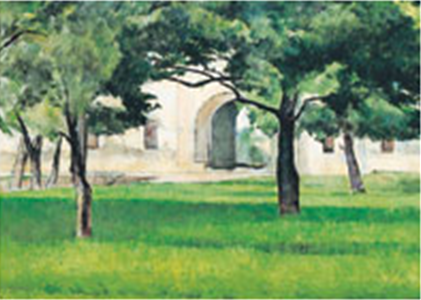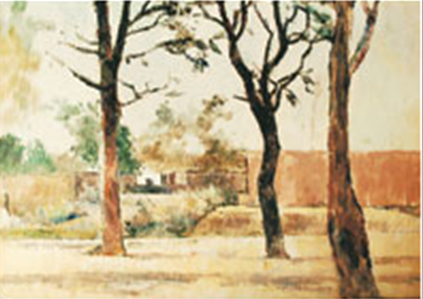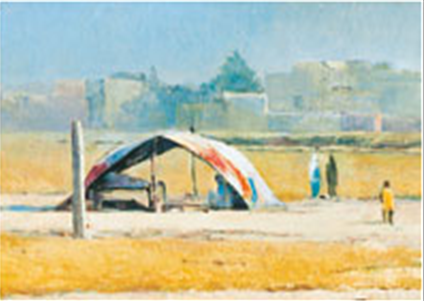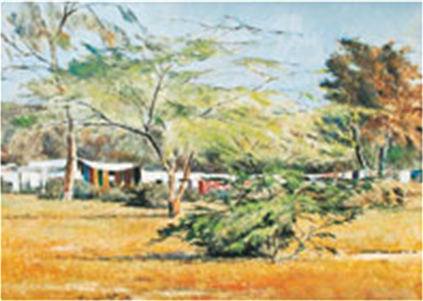Khalid Iqbal
This is a collection of information obtained from the World Wide Web. |
A backgrounder
Sourced from the World Wide Web
Prof. Khalid Iqbal (23 June 1929 – 19 June 2014) was a Pakistani painter, art teacher, and professor emeritus. He is known for his landscape paintings as well as his natural forms paintings and portraits of Punjab, Pakistan. He was born on 23 June 1929 in British India (in modern-day Simla, India). He attended St Joseph's Academy, Dehradun where he obtained his O levels education. In 1949, he obtained bachelor's degree from Forman Christian College, and diploma in French in 1952 from the Oriental College. He took art classes in the evening at the Mayo School of Arts (now known as the National College of Arts).
In 1954, he received a scholarship to study at the Slade School of Fine Arts in London. He returned to Pakistan in 1957 and joined the faculty of the National College of Arts. He served as the Principal of the NCA from 1974 to 1981. He retired from teaching in 1981 but continued to paint and exhibit his work. He was awarded the Pride of Performance in 1983 and the Tamgha-e-Quaid-e-Azam in 1992. He died on 19 June 2014 in Lahore, Pakistan.
Iqbal's paintings are characterized by their realistic depiction of the natural world. He often used muted colors and a hazy atmosphere to create a sense of tranquility and beauty. His paintings have been exhibited in solo and group exhibitions in Pakistan, India, Europe, and the United States. His work is included in the collections of the National Museum of Pakistan, the Lahore Museum, and the Karachi Museum.
Iqbal was a major influence on the development of modern Pakistani art. He was a mentor to many young artists and his work inspired a new generation of painters to explore the possibilities of landscape painting. He is considered one of the most important Pakistani artists of the 20th century.
Khalid Iqbal
The Marvel That Is Khalid Iqbal
By Munawar Ahmad
Prof Khalid Iqbal is a legend in his lifetime. He has brought realism to painting with impressionistic treatment of colour and light, thus creating a veritable atmosphere in his landscapes.
The works exude involvement and truthfulness. A feeling of space and his sensitivity to light in its impingement on the open plains, the foliage or on the rough foreground make the paintings realistic as they are. The so near-real life depiction of light makes one conscious of the season in which a painting is set. So realistic are Iqbal’s canvases that one can even sense the temperature at which the canvas was painted on the given day.
The professor’s journey to the President’s Medal of Pride of Performance started at the Slade School of Art in London. It was a little over 45 years ago when a chance glance of the celebrated English painter, John Piper, fell on a painting by Iqbal, as he was walking down the corridor at the Slade delivering a lecture. He turned around and exclaimed, “I have never seen such a beautiful painting here before! Who is the boy who has done it?” The boy was instantly sent for.
Addressing Iqbal, John Piper remarked, “Young man, you possess the talent to show nature in its natural tones. This painting appears to have been made during mid-morning; indeed, I can even smell the rising aroma of the grass”. He then added, “You have a along way to go!”
Listening to such eloquent praise from so eminent an artist and art critic, Iqbal says he stood there dumbfounded.
His admission to the Slade School of Art is another extraordinary tale. In 1949, after doing his B.A., Iqbal started to teach art at Aitcheson College, Lahore. During this period he heard of the Slade’s reputation and stature in the world of art. This inspired in him a desire to seek further education there. Consequently he wrote a plain and simple letter to the principal, enclosing a small watercolour done by him, stating in all humility that he had an irrepressible passion for painting; but, as he was thousands of miles away, he was hardly in position to sit for an admission test.
When the Principal set his eyes on the enclosed small watercolour, he recognised the unusual talent and wrote back immediately, “Get to London at once, we are offering you admission.”
Slade’s principal was Sir William Coldstream, whose engaging personality traits became an emulative torch for Iqbal. Many years latter when Colin David went to Slade School on a scholarship, Coldstream greeted him and after exchanging niceties he enquired, “Tell me how is Khalid Iqbal?” Colin David though feeling happy for his mentor quizzed, “Sir, do you still remember him?” Mr. Coldstream exuding all nostalgia replied, “Yes, of course. As a matter of fact we all remember him here.”
Iqbal was lucky to be in London at that time when different art movements were developing. If he has been overly impressed by any single European painter it is Cezanne. Doubtlessly, Cezanne is considered the bridge between the realism of impressionists and abstractionism of modern painters. It is because of this that Cezanne is called the progenitor of modern art.
Amongst Pakistani painters Ustad Allah Bakhsh followed the traditions of the English painters. Although he was a landscape painter his works gave prominence to Punjabi folk themes and the rural culture. Indeed the imaginative characters of Ustad Allah Baksh got spawned in his studio.
Against this Iqbal takes the trouble of proceeding physically to the locale which he wishes to paint. This is so because he wants show nature in its magical realism. Although his paintings are true delights of nature, quite a few especially those of industrial suburbs contain a certain touch of melancholy where some of his earnest and sombre temperament quietly seeps into his landscapes.
Many of Iqbal’s paintings have the onlooker contemplate the stillness of a purely visual world from which all human activity has been banished. His landscapes rarely contain human figures. The meticulously painstaking, yet creative, technique leaves the viewer possessed; as if in a trance, enjoying and totally lost, listening to an emotive movement of a great symphony.
Iqbal has undertaken painting in almost all seasons to depict prevailing light effects. Here and there one sees thrushes on barren land with noontime light giving a palpable sense of the heat under a hazy, dusty sky; and at time moisture-laden dark clouds over still water, between green fields, give the sensation of wetness in the air as if it has rained only moments ago.
His paintings of early morning mist cleaving to the shadows of distant trees give an all but sensed feeling of extreme cold. In one of his canvasses, green ivy is seen layering the surface of motionless water of a village pond; it appears as if Iqbal has brought the ivy from somewhere and studiously spread it on his picture. It unmistakably gives the beholder a sensuous feeling of softness.
Iqbal says that no painting can be a facsimile of what it seeks to portray of the natural environ.
Iqbal is a very private individual in the true sense of the word and an epitome of humility. Perhaps drowned in the world of art he has forgotten his own self because of his commitment to art which is complete.
Many of Iqbal’s paintings have the onlooker contemplate the stillness of a purely visual world from which all human activity has been banished.





